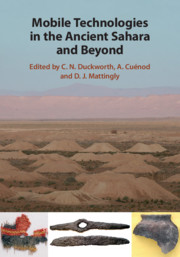Book contents
- Mobile Technologies in the Ancient Sahara and Beyond
- The Trans-Saharan Archaeology Series
- Mobile Technologies in the Ancient Sahara and Beyond
- Copyright page
- Contents
- Figures
- Tables
- Contributors
- Preface
- Part I Introduction
- Part II Technological Mobility and Transfers
- 2 Technological Innovations Transfer through the Hyper-Arid Belt
- 3 The Diffusion of Irrigation Technologies in the Sahara in Antiquity
- 4 Crafts in Roman North Africa
- 5 Movement and Management of Animals in the North and West of Africa from 1000 BC to AD 1000
- 6 The Early History of Weaving in West Africa
- Part III Metallurgy
- Part IV Glass Technology
- Part V Handmade Pottery
- Part VI Conclusion
- Index
- References
4 - Crafts in Roman North Africa
Technical Transfer and Permanence through Grain Mills and Fullonicae
from Part II - Technological Mobility and Transfers
Published online by Cambridge University Press: 18 September 2020
- Mobile Technologies in the Ancient Sahara and Beyond
- The Trans-Saharan Archaeology Series
- Mobile Technologies in the Ancient Sahara and Beyond
- Copyright page
- Contents
- Figures
- Tables
- Contributors
- Preface
- Part I Introduction
- Part II Technological Mobility and Transfers
- 2 Technological Innovations Transfer through the Hyper-Arid Belt
- 3 The Diffusion of Irrigation Technologies in the Sahara in Antiquity
- 4 Crafts in Roman North Africa
- 5 Movement and Management of Animals in the North and West of Africa from 1000 BC to AD 1000
- 6 The Early History of Weaving in West Africa
- Part III Metallurgy
- Part IV Glass Technology
- Part V Handmade Pottery
- Part VI Conclusion
- Index
- References
Summary
A study of production remains in the ancient Maghrib allows a reflection on the technology used by African craftsmen. Archaeological remains from the Roman period prove to be valuable indicators that can inform us about tools and manufacturing methods. In particular, the study of ancient grain mills and fulling workshops develops our understanding of the technical processes and helps clarify the restitution of the chaînes opératoires for different types of activities (transformation of foodstuffs, manufacturing and treatment of textiles, construction and decoration). If all steps are not identifiable based on the archaeological record, they can still be reconstituted with the contribution of ancient written evidence, iconographic representations or ethnography. This analysis leads on the one hand to reflections on the adoption of Roman techniques and types of production in this region, and on the other hand to questioning the permanence of local savoir faire.
- Type
- Chapter
- Information
- Mobile Technologies in the Ancient Sahara and Beyond , pp. 115 - 142Publisher: Cambridge University PressPrint publication year: 2020



